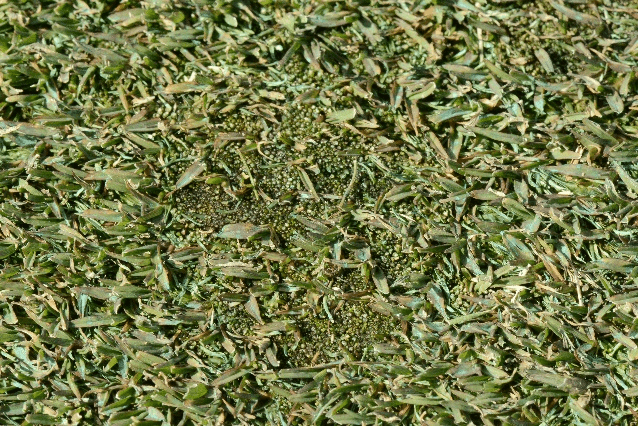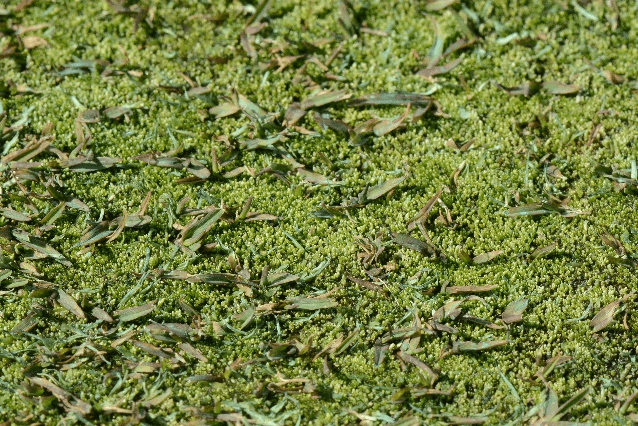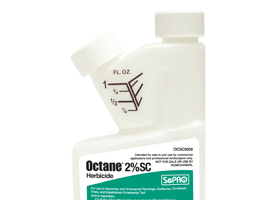Product Overview
Octane is a simple, economical solution to faster weed control. Best applied on a sunny day, weeds sprayed with Octane show visual herbicidal symptoms within 24-48 hours. Emerged weeds are quickly killed, helping in timely tournament prep or instant satisfaction by membership and greens committees. Octane is also safe to use on recently seeded turf, being gentle on desirable cool- and warm-season turfgrass such as Kentucky bluegrass, perennial ryegrass, tall fescue, bermuda grass, centipede grass, St. Augustine and zoysia grass.
Tough on weeds, gentle on the environment
With Octane, show your customers the results they want, when they want them. Octane takes out the toughest broadleaf weeds, delivering visual results within 24 - 48 hours of application.
Octane's active ingredient, pyraflufen-ethyl, has an in-soil half-life of less than 24 hours, ensuring rapid in-soil breakdown following application. Octane is rain-fast within an hour, delivers outstanding results with little active ingredient per acre, has low water solubility and low vapor pressure, reducing potential off-target movement and its effect on the environment.
Increased speed of kill
Satisfied membership and greens committee
Labeled for use on cool- and warm-season turf
Excellent turf safety for locations with multiple turf species
Very short half-life
No limitation to turf establishment after application
Rainfast in 1 hour
Little chance for interference from weather or irrigation
Low vapor pressure
No movement to non-target areas
Low use rate
Lower environmental impact
Effective in all climates
No temperature restrictions, hot or cold.
Octane is a registered trademark of Nichino America, Inc.
Silvery Thread Moss Control
A new option for silvery thread moss control
Octane is now registered for silvery thread moss control. With a combination of efficacy, turf safety, and value, Octane is your go-to solution for silvery thread moss control.
- Applications should be made at 2 to 6.8 fl. oz./acre
- Repeat applications are recommended for complete control at a minimum 14-day interval
- Research has demonstrated Octane can be applied to creeping bentgrass putting greens at 6.8 fl. oz./acre without concern for turf injury

Octane 4 fl oz/A 10 days

Nontreated
Application Instructions
Applied Alone. For Best Results:
- Apply Octane at rates of 1 to 4 fl. oz./acre for control of seedling, non-mature winter and summer annual weeds and/or for temporary burndown of weeds listed on Control Spectrum page.
- Tank-mixing Octane with other broadleaf herbicides may be needed for control of larger winter and summer annual weeds.
Applied in Tank-mix. For Best Results:
- Apply Octane at rates of 0.7 to 1.5 fl. oz./acre in tank-mix combinations with herbicides registered for use such as amines, esters, and salts of 2,4-D, chloroprop, dicamba, mecoprop, triclopyr, fluroxypyr, and various combinations of these products for control of annual weeds and perennial weeds
- Residual, long-term control of the target weeds is as defined by labeling of the companion product
- For tank-mixing with herbicides, always read and follow the product label directions
Spray Volume Notes:
- Octane is a contact herbicide that causes herbicidal symptoms only to plant parts that come into contact with spray applications
- Proper spray volume and uniform coverage are important to maximize efficacy of Octane
- Uniform sprays should be applied at 20 to 200 gal per acre (0.5 to 4.5 gal. per 1000 sq. ft.)
- Higher spray volumes should be used to target whole weed population and/or weeds contained in dense turfgrass canopies
Use of Adjuvants Notes:
- Addition of surfactants (spreaders/stickers) to the spray solution will improve efficacy and contact activity of Octane
- Follow manufacturer’s use rates for specific sites
Control Spectrum
Amaranth, Palmer
Bedstraw
Beggartick, Florida
Beggartick, hairy
Bindweed, field
Buckwheat, wild
Canada thistle
Canola
Carpetweed
Celery, wild
Chickweed
Clover, white
Cocklebur
Mustard, wild
Nettle, stinging
Nightshade, black
Pigweed, redroot
Pigweed, smooth
Pineappleweed
Poinsettia, wild
Poison ivy
Purslane, common
Radish, wild
Ragweed, common
Ragweed, giant
Rocket, London
Dandelion
Dock, curly
Dollarweed
Eclipta
Evening-primrose, cutleaf
Henbit
Knotweed, prostrate
Kochia
Ladysthumb
Labsquarters, common
Lettuce, prickly
Mallow, common
Morning Glory
Russian, thistle
Sesbania, hemp
Shepherds purse
Sicklepod
Smartweed, Pennsylvania
Smell melon
Sowthistle, annual
Spurge, leafy
Sunflower, common
Toadflax, Dalmation
Velvetleaf
Waterhemp, tall



